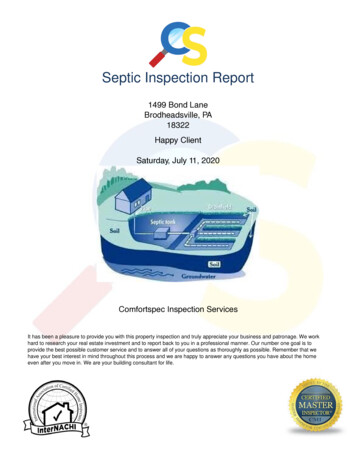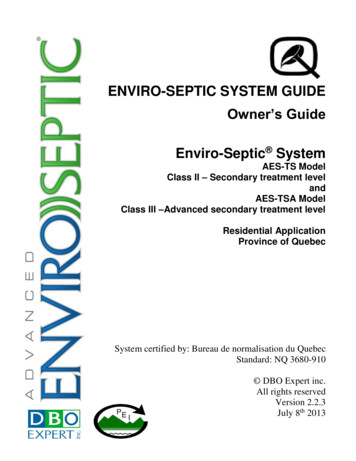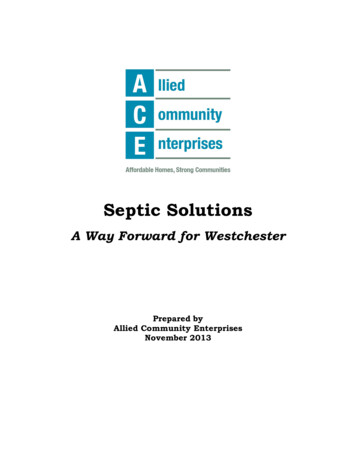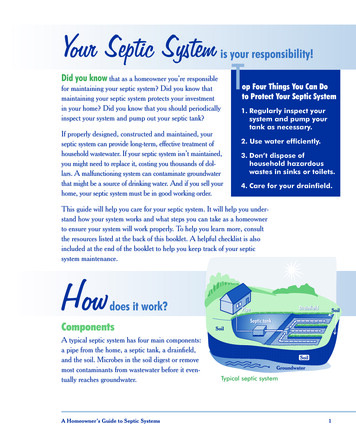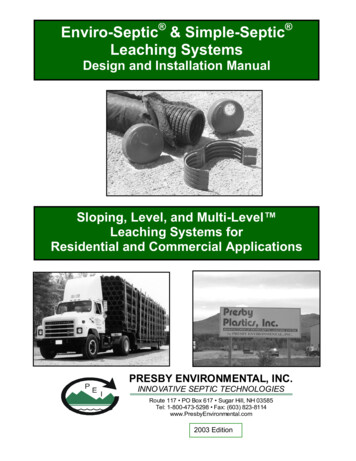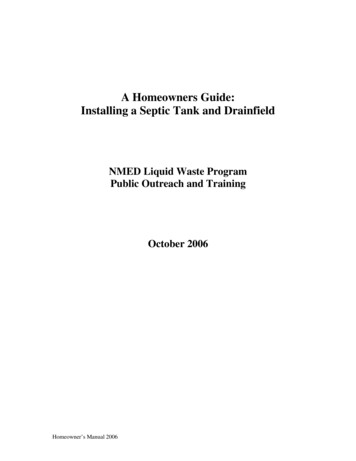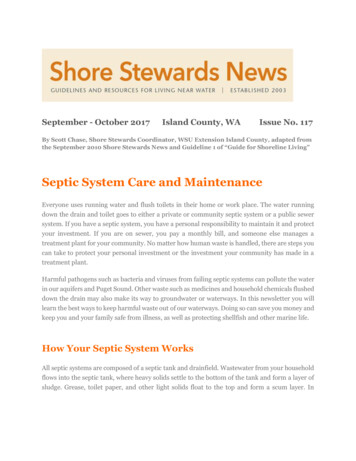
Transcription
September - October 2017Island County, WAIssue No. 117By Scott Chase, Shore Stewards Coordinator, WSU Extension Island County, adapted fromthe September 2010 Shore Stewards News and Guideline 1 of “Guide for Shoreline Living”Septic System Care and MaintenanceEveryone uses running water and flush toilets in their home or work place. The water runningdown the drain and toilet goes to either a private or community septic system or a public sewersystem. If you have a septic system, you have a personal responsibility to maintain it and protectyour investment. If you are on sewer, you pay a monthly bill, and someone else manages atreatment plant for your community. No matter how human waste is handled, there are steps youcan take to protect your personal investment or the investment your community has made in atreatment plant.Harmful pathogens such as bacteria and viruses from failing septic systems can pollute the waterin our aquifers and Puget Sound. Other waste such as medicines and household chemicals flusheddown the drain may also make its way to groundwater or waterways. In this newsletter you willlearn the best ways to keep harmful waste out of our waterways. Doing so can save you money andkeep you and your family safe from illness, as well as protecting shellfish and other marine life.How Your Septic System WorksAll septic systems are composed of a septic tank and drainfield. Wastewater from your householdflows into the septic tank, where heavy solids settle to the bottom of the tank and form a layer ofsludge. Grease, toilet paper, and other light solids float to the top and form a scum layer. In
between the sludge and the scum is asemi-clear layer of wastewater calledeffluent that does not include solids.As more wastewater enters the septictank, the clear effluent layer of thetank flows through an outlet in thetank to the drainfield in your yard.The “good” bacteria living in the soilclean the wastewater by consumingharmful bacteria and viruses beforethiswastewaterseepsintogroundwater.The “good” bacteria in the septicsystem do not completely decompose the sludge or scum layers, so the layers continue to grow,slowly filling up the tank over time. These layers will eventually need to be pumped out by aprofessional septic pumper. No special additives are necessary or recommended.There are several types of septic systems, and it is important to understand what kind you haveand the requirements for its specific maintenance and inspection. The most common type is thegravity system, which does not require a pump to operate. Others include the pressuredistribution system, sand filter system, mound system, and aerobic treatment units such as theGlendon BioFilter system.What Should Go Down the DrainWhether you are connected to a large sewer system or your own onsite septic the only things thatshould go down the drain are human waste, toilet paper, mild soaps and detergents. Many itemscan clog the screens at your community’s sewage treatment plant or compromise your septic tankor drainfield—even those that say they are “flushable.” To avoid damaging your septicsystem or community sewage treatment plant, you should: Limit use of chlorine bleach to less than ½ cup per laundry load. Bleach kills the “good”bacteria in the tank and drainfield. Avoid using a garbage disposal, as the microbes in your septic tank don’t do a good job ofbreaking down undigested fruit, coffee grounds, eggshells, vegetables, and meats. Use the trash bin to dispose of used baby wipes, cleaning wipes, facial tissues, sanitarynapkins, tampons, condoms, band aids or bandages, cotton balls or swabs, Q-tips, dentalfloss, disposable diapers, hair, and paper towels.
Keep kitty litter and pet waste out of the toilet. These do not break down like human wasteand should be bagged and placed in the trash. Use an ashtray, not the toilet, for cigarette butts and matches. They do not disintegrateand can harm your septic system and clog your drainfield. Use drain screens to keep hair, fruit sticker labels, and other small items from going downthe drain. Scrape cooled grease and other food waste into the compost or trash before washing, sothere is less work for your septic to do. Use a drain snake for plumbing system clogs, which is readily available at hardware stores,or follow this recipe:oMix ½ cup baking soda, ½ cup vinegar, and ½ cup boiling water.oPour quickly into clogged drain and let stand for 2–3 minutes.oThen flush with water.Maintaining Your Septic SystemMaintaining your septic system is a good investment. Here is a checklist of actionsyou can take to ensure your system has a long life: Get a copy of your septic system’s “as-built” drawing from your Health Department if youdo not have one. This drawing should show the location of your septic tank, drainfield, andall septic parts. Ensure that no vehicles or heavy machinery drive over any portion of your system. Keep records of any pumping or repairs. Inspect your system regularly. Depending on the type of system you have, therecommended inspection frequency may vary from every 6 months to every three years atmost. Check with your Health Department to see how often you need to have your type ofsystem inspected. Some counties allow you to complete your own inspection, and offerliterature, classes, or videos on how to do so. Pump your system when necessary. Clean septic tank filters asrecommendedoratleastannually, if you have them. Installinspectionrisers(extension tubes from the top ofthe tank to the surface thatmakes it easier to access yoursystem to inspect or pump).
Spread out the timing of water use around the house. Take showers and baths when thedishwasher or washing machine is not in use. Limit dishwashing or laundry loads to onecycle daily or space out loads to allow the system to process the water. Reduce water use. Guideline 8 has some great ideas on how to conserve water. Consider renting a port-a-potty for large events to avoid putting stress on your system.Protecting Your DrainfieldYour drainfield is critical to the health of your septicsystem and needs to be protected. The pipes and othercomponents in your system may not be buried very deepbelow ground and could be easily crushed. The soils inyour drainfield contain oxygen-loving bacteria that breakdown and filter the effluent. If the area is compacted bydriving or parking on it, the bacteria won’t be as effectiveand will reduce the ability of the water to percolatethrough the soil. You will also want to avoid doing anything that overwhelms the system with toomuch water.To protect the lifespan of your drainfield, avoid these activities. Building structures on the drainfield, including tool or garden sheds, decks, sport courts,patios, swing sets, sand boxes, or compost bins. Parking or driving vehicles or construction equipment on the drainfield. Planting trees and large shrubs near the drainfield. They should be planted at least 30feet away to prevent roots from getting into and breaking or clogging the drainfield pipes. Using a rototiller which could damage the system parts that are close to the surface. Over irrigating in the drainfield area, as this could saturate the soil and decrease the abilityof the system to function properly. Directing water from your downspouts and surface water runoff onto your drainfield. Burning piles of leaves or branches over the drainfield, as the heat could damage theplastic pipes below, if they are buried shallowly. Using plastic sheeting over these areas in an attempt to block weed growth. Using too much topsoil or compost. Limit to no more than two to three inches over thedrainfield.A good rule of thumb for landscaping over drain fields is to use shallow rooted plants.
Many grasses have shallow root systems and are the simplest and most frequently recommendedplantings over the drainfield. Choose a traditional lawn or perhaps an un-mowed meadow. Youmay include permeable pathways, garden ornaments, bird baths, sundials, tables and benches.In sunnier locations, perennial gardens can be created with mixes of ornamental grasses ofdifferent heights and can be inter-planted with ground covers, small bulbs, and sun lovingperennials as well as smaller, shallow rooted shrubs. Avoid larger ornamental grasses andbamboo, which are known to harm septic fields.TIP: Avoid planting vegetables over your drainfield. Vegetables often need daily watering andexcess water in the soil reduces the drainfield’s ability to treat wastewater. Roots of somevegetables may grow deep enough to damage, or clog drain pipes. If the drainfield is not workingproperly, the effluent in the drain field could contaminate the vegetables.Fortunately, there are many recommended plant species, with a few listed below. When installingplants, limit topsoil additions to only one or two inches. Consider using seeds or small starts.Deep Shade PlantsPartial Shade/Sun PlantsSun PlantsJapanese SpurgeBlue Star CreeperKinnikinnickIrish MossVaccinium Well’s DelightBlue Oat GrassWintergreenCreeping RubusVaccinuim Well’s DelightSword FernSword FernBlue-silver fescueSigns of a Failing Septic SystemSeptic systems are designed to have a lifespan of 20 to 30years, although many last longer. The most common causeof early failure is improper maintenance. A wellmaintained system is one that is inspected at therecommended frequency and maintained as necessary. Asystem that is not pumped when needed will result in abuild-up of sludge and floating solids, such as greases and
toilet paper, inside the septic tank. If these build up too much they will flow out of the tank intothe drain field, causing it to become clogged beyond repair. Other causes of failure can includepipes blocked by roots, crushed pipes, over-saturation of the soils, flushing of inappropriate items(like cigarette butts), poor design, or poor installation.YOU KNOW YOU HAVE A SERIOUS PROBLEM IF YOU EXPERIENCE ANY OF THEFOLLOWING Sewage backing up in your toilets, sinks, or bathtubs. Slow flushing toilets, as well as drains that are draining much slower, even after usingplungers or “plumbers’ snakes.” Water pooling in your yard or accumulating near your septic tank. This water may or maynot be accompanied by a foul or “rotten egg” odor. Black or dark grey stains in soil or grasses on the drainfield or surrounding areas. Overly moist or mushy areas in your drainfield area. Algae growth on subsurface drainage pipe outlets, bulkheads, or visible seeps on the beachor along the stream.If your septic system appears to be failing: Avoid using septic system “miracle cures” that promise to get rid of the sludge and scumin your system. “Miracle cures” may dissolve the sludge and scum, sending dissolvedparticles into your drainfield, potentially clogging the soils in the drainfield and requiringexpensive drainfield repair or replacement. Contact your local health department or surface water agency to find out if their staff maybe able to assess your situation and give you advice on how to solve the problem. Yourlocal conservation district may also be helpful. These organizations may also be able toconnect you with special loan programs for repairing your system. Fence off areas if there is liquid waste seeping to the surface of your yard so that pets andpeople, especially children, are not in contact with the liquid. Conserve water as described in Guideline 8. This can extend the life of your system if itturns out it has not failed completely. Have your system pumped and filters cleaned, combined with some drastic waterconservation around the home, may help solve the problem temporarily, as an empty tankcan hold up to several days of waste.
Ways to save moneyMaintaining and repairing your septic system can be expensive, which is why you should inspectyour system regularly. This can be cheaper than having it pumped when it’s not necessary.Because of the importance of maintaining your system to your county’s public health department,there are sometimes coupons, classes, incentives, and low-interest loans available. Check withyour health department or surface water agency. Septic class information for north Puget Soundcounties can be found in the References section that follows.References and ResourcesWashington Sea Grant: Download publications on septic system maintenance and care, landscapingyour drainfield, pumping your septic system and more: lam County Environmental Health Septic Systems (Onsite ealth/onsite.htmlIsland County Public Health Septic Training: ferson County Public Health “Resources for th.org/665/Resources-for-HomeownersKitsap County Public Health District: Homeowners Guide to Onsite Sewage ent/files/homeownersguide.pdfMason County Septic Education (Mason County Public Health and WSU sources/septic-system-education/Skagit County Environmental Health Septic /HealthEnvironmental/septic101.htmSnohomish County Health District “Septic Care Workshops and ptic-Care-Workshops-ResourcesWhatcom County Environmental Health “Homeowner wner-Training-OM
If you would like to download or view previous Shore Steward newsletters, please wards/newsletters/ Your Shore StewardsCoordinator is Scott Chase, (360) 678-8239, or email at schase@wsu.edu.Support Shore Stewards in Island County! If you would like to see this program continue to make adifference in Island County, please consider making a donation to the WSU Shore Stewards ExcellenceFund: https://secure.wsu.edu/give/default.aspx?fund 496 Your tax-deductible donation will help ensurefuture funding for newsletters, demonstrations at local events, and to make sure that the program andeducational materials continue to be free for shoreline landowners and others interested in protecting ourislands. Thank you for your contribution!Thank you for reading Shore Stewards News.Shore Stewards, Washington State University, Pullman, WAAccessibility Copyright PoliciesWSU Extension programs and employment are available to all without discrimination. Evidence ofnoncompliance may be reported through your local WSU Extension office.
Septic System Care and Maintenance Everyone uses running water and flush toilets in their home or work place. The water running down the drain and toilet goes to either a private or community septic system or a public sewer system. If you have a septic system, you have a personal responsibility to maintain it and protect your investment.


